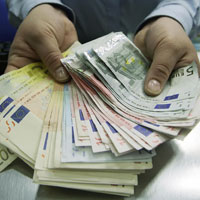We continue to live in highly volatile times with rapid and large movements in either direction when it comes to currency exchange rates.
Mid 2010, investors seemed to be convinced that the euro was the pariah of the western world’s currencies and was headed towards parity against the US$ [I must admit, that was an extreme forecast] and was going to hit €1.25/£1 and beyond against sterling.
Then quantitative easing came to the fore. The US made it clear that another bout of quantitative easing was very much on the agenda and the UK began to ponder such a possibility. Before any firm decision was made by either the Federal Reserve or the Bank of England, we saw a complete reversal in the euro’s fortunes.
Instead of the euro heading towards parity against the US$ we saw it go in the other direction and pass through US$1.40/€1 as it hit levels last seen 12 months ago. We also saw the euro-sterling exchange rate return to levels seen nine months ago, as it fell by nearly 10 percent in just over a month and hovered around the €1.13-1.14/£1 level. And as mentioned, no firm commitment had actually been made by the respective central banks to undertake further quantitative easing; it was, quite simply, the possibility of further quantitative easing taking place that caused the rapid change in sentiment.
When the Federal Reserve finally confirmed its programme of quantitative easing at US$600 billion the market reaction was muted. Not surprising, given that it was in line with expectations. In the UK, the Bank of England has made it clear that no decision will be made for a few months, so we are in holding pattern with current economic data supporting the view that there will be no need for further quantitative easing.
So some level of stability and clarity has returned for the US$ and for sterling.
And what of the euro?
We now have the Irish government bailout. I have highlighted previously that the debt problems in the euro zone; government and bank, are far from over and it was only a matter of time until we had round two [round one was the bailout of Greece last year].
It was interesting to see how, even though the Irish government didn’t have any immediate need to raise any more money on the markets, pressure was brought to bear by yields on Irish government bonds increasing significantly and by funds being withdrawn from the Irish banks – which meant that the banks working capital was being eroded. This forced the European Central Bank, certain Euro zone governments’ – most noticeable Germany, the UK government and the International Monetary Fund all having to ride to the rescue. On the back of this, the euro lost ground.
The trouble is that we still have two further rounds to go; round three is Portugal and round four is Spain, and the size of the problem is getting larger each time.
First time around the euro zone was able to sort out matters in Greece. With Ireland, the UK and the IMF had to be involved. The size of the Portuguese debt problem is still just about manageable but when it comes to Spain the size of the debts are such that the resources of the ECB and the IMF will in all likelihood, be insufficient to cope.
And then I think we will be into the end game. Does the euro zone survive in its current form, does it have two “divisions” or does it have to break asunder?
Politically, I think there is still a belief that one size fits all. But to the rest of us, this assumption would appear to be nonsensical. The German and French economies continue to recover, while the economies of Greece, Ireland, Portugal and Spain continue to suffer. And those economies that suffer are not able to devalue their exchange rate, which would help to boost exports, as they have the euro.
What I have always found strange is that each government in the euro zone issues its own bonds – and as such they have their own interest rates and they have their own liability. But what happens if a country defaults? How can a euro not be worth a euro? I certainly don’t understand how this can happen. The German government seems to think that this is okay, whereas the markets take the different view and as such we could see some very interesting court cases if such an event ever occurred.
So a lot of unknowns – and as such, the only conclusion which seems sensible at this moment in time, is that the euro is going to be under pressure until the market is really convinced that the debt problems in Spain have been sorted out in a way that removes any doubts.
And that will take quite a while.
Charles Purdy is a director at Smart Currency Exchange. Tel: 0207 898 0541; www.SmartCurrencyExchange.com, www.SmartCurrencyBusiness.com





